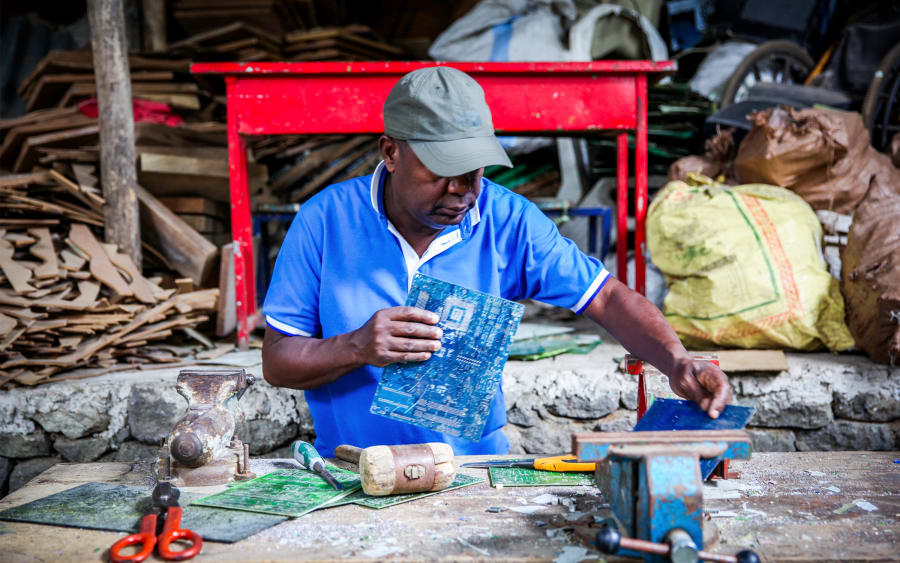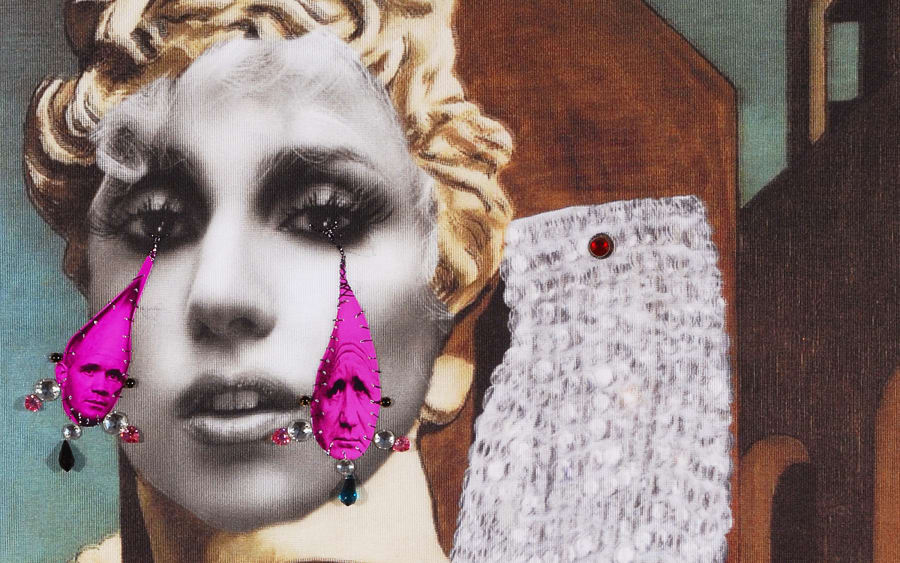The wave of Indigenous and First Nations artists exhibiting in national pavilions for the first time is undoubtedly the Venice Biennale’s most significant development in recent years. In 2019, the Isuma collective became the first Inuit artists to occupy the Canadian Pavilion, with Zacharias Kunuk’s film, One Day in the Life of Noah Piugattuk (2019), recounting the forced relocation of Inuit people in Canada. Then the Nordic Pavilion transformed into ‘The Sámi Pavilion’ in 2022, with artists Pauliina Feodoroff, Máret Ánne Sara, and Anders Sunna illuminating an Indigenous community stretching from Norway to Russia, as Yuki Kihara became the first Pacific, Asian, and fa’afafine artist to represent Aotearoa New Zealand.
Historic firsts continue at the 60th Venice Biennale, with Jeffrey Gibson becoming the first Indigenous artist to stage a solo exhibition in the US Pavilion; Glicéria Tupinambá marking the same milestone by renaming Brazil’s pavilion to Hãhãwpuá, the land’s ancient Pataxó name; and Inuuteq Storch raising a ‘Kalaallit Nunaat’ sign, for Greenland, at the Danish pavilion, as the first Greenlandic and Inuk artist to represent Denmark.
‘Stranieri Ovunque – Foreigners Everywhere’, the Venice Biennale’s central show, likewise reflects a growing Indigenous presence among its 331 artists. After presenting larrakitj ceremonial poles at Art Basel Hong Kong, Naminapu Maymuru-White, one of the first Yolŋu women of Northern Australia taught to paint sacred creation clan designs known as miny'tji, is exhibiting maps painted on stringybark tracking the journey of two ancestral spirits from the Maŋgalili homeland to the Milŋiya river’s mouth, where they became stars. While Mataaho Collective – Erena Baker, Sarah Hudson, Bridget Reweti, and Terri Te Tau – have created a monumental ratchet-strap weave drawing on Māori systems for transporting heavy loads, recalling the collective’s interventions at the 2023 Gwangju Biennale and 2020 Biennale of Sydney.
Among the participants in Sydney’s historic 2020 Biennale, which was led by an Aboriginal artistic director, Brook Andrew, for the first time, was Girramay, Yidinji, and Kuku-Yalanji artist Tony Albert. Albert presented Healing Land, Remembering Country (2020), a wooden greenhouse where visitors were invited to write messages on handmade paper embedded with native seeds, which were then planted. That project extended from Gubangala Gumadangyiningi (Let's honour his/her spirit) (2018), a collaboration between Albert, Dharug woman Julie Bukari Jones (Webb), and families in Blacktown, which honored Indigenous children forced to reside at the former Blacktown Native Institution, established in the 19th century as part of a settler-colonial assimilation campaign.
As the Art Gallery of New South Wales’s first Indigenous Trustee, Albert’s advocacy has grown with his art. For this year’s Biennale of Sydney, he guided 14 commissions by First Nations artists – including the brilliant Yankunytjatjara artist Kaylene Whiskey; Diné weaver and fiber artist Eric-Paul Riege; and Aymara Bolivian architect Freddy Mamani – as the inaugural Fondation Cartier pour l’art contemporain First Nations Curatorial Fellow. Albert describes the experience as unique. Rather than directing him, the foundation asked how it could help. ‘This is a way of working that I’m not used to as an Aboriginal person,’ says Albert, who acknowledges the strides made in the arts while highlighting the work that remains. ‘You can’t Indigenize space without Indigenized peoples. That comes with putting First Nations first,’ Albert explains. ‘It’s about conduits, connections, and long-term engagement.’
The necessity for sustained engagement connects to the 2024 Venice Biennale, where ‘Indigenous artists have an emblematic presence,’ writes artistic director Adriano Pedrosa – emblematic being the operative word. ‘It’s important to be part of the conversation rather than the subject of it,’ says Mataaho’s Sarah Hudson, reflecting on the Biennale’s roots in colonial-era World’s Fairs, which notoriously displayed Indigenous people as exhibits. ‘We are continually critically analyzing where we are being platformed, and with international opportunities like this, we get to connect with other Indigenous creatives,’ continues Erena Baker. ‘Within our own homelands, we are treated as foreigners. It’s occupied land. So wherever we go, we have to represent ourselves regardless.’
I met Hudson and Baker in the UAE, where they spoke on a panel of First Nations artists at the Culture Summit Abu Dhabi with Daniel Boyd and Nicholas Galanin, who both pointed out that Indigenous cultures precede international exhibitions. ‘We’re talking about the continuum of cultural inheritance,’ Boyd told me, describing Australia’s Indigenous peoples as the oldest continuous culture on earth and highlighting the Aboriginal Tent Embassy, an ongoing protest for Indigenous land rights that began in 1972. ‘We continue our relationship to land with or without that idea of perceived value in the system that was designed to extract everything, including our knowledge,’ added Galanin, whose solo show at the Baltimore Museum of Art opens this July as part of the ‘Preoccupied: Indigenizing the Museum’ initiative. Bougainville-born artist Taloi Havini, who was awarded the Artes Mundi 10 prize in January this year, echoes their points: ‘Land and ocean are integral to our whole being. It’s something that you’re from, that you inherit from deep time.’
Havini is the curator of ‘Re-Stor(y)ing Oceania’ at Ocean Space in Venice, which opened this March. Site-specific commissions by Latai Taumoepeau and Elisapeta Hinemoa Heta have been conceived as a call and response within the church of San Lorenzo. Taumoepeau’s Deep Communion sung in minor (ArchipelaGO, THIS IS NOT A DRILL) is a 16-channel sound installation with recordings of the sea heard in the space, as eight standing paddle machines emit the voices of a Tongan youth choir performing the ancient ceremonial chant me’etu’upaki when paddled. The Body of Wainuiātea, named after the mother of oceans and waterways, follows. Heta used earthen bricks, fabrics, gourds, coconut oil, and timber to create an ātea, a ceremonial clearing that is opened and closed daily with a karanga: a Māori women’s spiritual call to welcome the living and ancestral.
Heta connects her installation to an ongoing collaboration with Dr. Albert Refiti, which explores Pacific architectures and their connections to varying cosmological worldviews. As Havini emphasizes, the Pacific islands, like Indigenous cultures in general, are diverse – much like Aboriginal Australia, with over 300 language groups representing distinct laws and traditions. But the ocean is a connector, says Heta. ‘The colonial view has always been to make our islands seem small and our people seem few in number, but we conceived of ourselves as being part of the whole ocean.’ From Alaska to Micronesia, Heta describes ‘a big story to be told, and interconnected conversations that we have not been able to have for a long time.’
Stories and interconnected conversations are at the heart of ‘Re-Stor(y)ing Oceania’. While exhibitions open in Venice, the International Seabed Authority is issuing licenses for deep-sea mining, but ‘we don’t hear about or see these things,’ Taumoepeau says. ‘So with an issue like this, our currency is our stories, because they place us in that physical space.’ ‘Re-Stor(y)ing Oceania’ amplifies this position. ‘Our stories say no,’ Havini stresses. ‘We don’t want you to extract this body of water, our origin, our ancestry, our life.’
But protecting earth is a global effort, which returns to exhibitions like the Venice Biennale. There remains a tendency to ‘Blakwash,’ says guerrilla collective Yangamini, whose butt-plug sculptures made from materials native to the Tiwi Islands at the Sydney Biennale are protesting the construction of an undersea pipeline in the Timor Sea, referring to institutions platforming Indigenous artists without supporting their struggles. ‘We use this term, cultural load, when you’re First Nations and all the work is dumped on you,’ explains Yangamini accomplice Jens Cheung, recalling Tony Albert’s point about decolonization having nothing to do with Aboriginal people. ‘It’s not our job to decolonize space that is a colonial construct,’ Albert says. Udeido Collective, also participating in the Sydney Biennale, are finding ways to transfer the burden. At Biennale Jogja in 2021, the collective, which highlights human and environmental rights violations in West Papua, invited a non-Papuan performer to activate their installation. ‘It was an effort to transmit understanding and knowledge about Papua and grow the solidarity movement,’ says co-founder Dicky Takndare.
The need to learn and connect in solidarity is becoming more urgent amid the climate emergency, which relates to landback as a movement to transform our relationships with earth as a living entity rather than property, and with each other. ‘In the context of climate change, the world stage and the local stage are not too different,’ says Taumoepeau, describing the proximity to sea-level rise, coming from a low-lying island and living in coastal Australia, as something she shares with Venetians. In that light, relationality is one way to connect with the Indigenous worldview, says Heta. ’Not to lump us together, and speaking from a Māori perspective, our strength is that we exist in relation to the water, mountains, and land, and we understand our genealogical relationship to them. Because of that, we can talk about our human and non-human relationships in a way that is very fluid, real, and tangible.’ As Taumoepeau states: ‘The invitation is for others to do that same labor.’
The 60th Venice Biennale runs from April 20 to November 24, 2024.
The 24th Sydney Biennale is on view until June 10, 2024.
‘Restor(y)ing Oceania’ is on view at Ocean Space in Venice until October 13, 2024.
Nicholas Galanin, ‘Exist in the Width of a Knife’s Edge‘ is on view at Baltimore Museum of Art from July 14, 2024 until February 16, 2025.
Stephanie Bailey is Art Basel’s Conversations Curator, Art Basel Hong Kong, as well as the Art Basel Content Advisor and Editor, Asia.
Caption for top image: Latai Taumoepeau, Deep Communion sung in minor (ArchipelaGO, THIS IS NOT A DRILL), 2024. Exhibition view of ‘Re-Stor(y)ing Oceania’, Ocean Space, Venice. Co-commissioned by TBA21–Academy and Artspace, and produced in partnership with OGR Torino. Photography by Giacomo Cosua.
Published on April 17, 2024.


